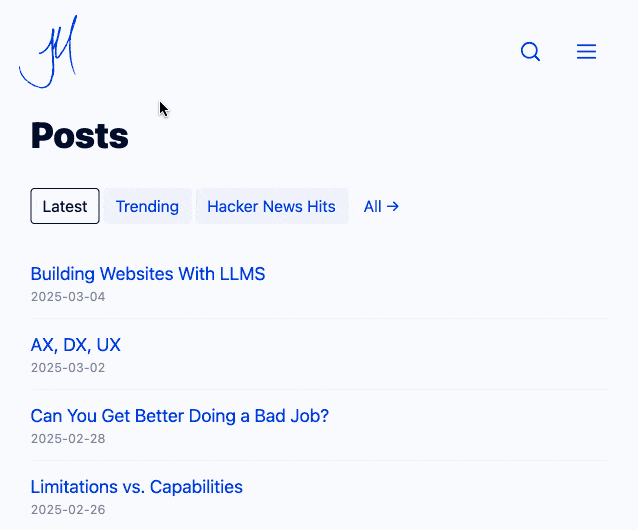Monday, 10th March 2025
Building Websites With Lots of Little HTML Pages (via) Jim Nielsen coins a confusing new acronym - LLMS for (L)ots of (L)ittle ht(M)l page(S). He's using this to describe his latest site refresh which makes extensive use of cross-document view transitions - a fabulous new progressive enhancement CSS technique that's supported in Chrome and Safari (and hopefully soon in Firefox).
With cross-document view transitions getting broader and broader support, I’m realizing that building in-page, progressively-enhanced interactions is more work than simply building two HTML pages and linking them.
Jim now has small static pages powering his home page filtering interface and even his navigation menu, with CSS view transitions configured to smoothly animate between the pages. I think it feels really good - here's what it looked like for me in Chrome (it looked the same both with and without JavaScript disabled):

Watching the network panel in my browser, most of these pages are 17-20KB gzipped (~45KB after they've decompressed). No wonder it feels so snappy.
I poked around in Jim's CSS and found this relevant code:
@view-transition {
navigation: auto;
}
.posts-nav a[aria-current="page"]:not(:last-child):after {
border-color: var(--c-text);
view-transition-name: posts-nav;
}
/* Old stuff going out */
::view-transition-old(posts-nav) {
animation: fade 0.2s linear forwards;
/* https://jakearchibald.com/2024/view-transitions-handling-aspect-ratio-changes/ */
height: 100%;
}
/* New stuff coming in */
::view-transition-new(posts-nav) {
animation: fade 0.3s linear reverse;
height: 100%;
}
@keyframes fade {
from {
opacity: 1;
}
to {
opacity: 0;
}
}Jim observes:
This really feels like a game-changer for simple sites. If you can keep your site simple, it’s easier to build traditional, JavaScript-powered on-page interactions as small, linked HTML pages.
I've experimented with view transitions for Datasette in the past and the results were very promising. Maybe I'll pick that up again.
Bonus: Jim has a clever JavaScript trick to avoid clicks to the navigation menu being added to the browser's history in the default case.
It seems to me that "vibe checks" for how smart a model feels are easily gameable by making it have a better personality.
My guess is that it's most of the reason Sonnet 3.5.1 was so beloved. Its personality was made much more appealing, compared to e. g. OpenAI's corporate drones. [...]
Deep Research was this for me, at first. Some of its summaries were just pleasant to read, they felt so information-dense and intelligent! Not like typical AI slop at all! But then it turned out most of it was just AI slop underneath anyway, and now my slop-recognition function has adjusted and the effect is gone.
— Thane Ruthenis, A Bear Case: My Predictions Regarding AI Progress
llm-openrouter 0.4. I found out this morning that OpenRouter include support for a number of (rate-limited) free API models.
I occasionally run workshops on top of LLMs (like this one) and being able to provide students with a quick way to obtain an API key against models where they don't have to setup billing is really valuable to me!
This inspired me to upgrade my existing llm-openrouter plugin, and in doing so I closed out a bunch of open feature requests.
Consider this post the annotated release notes:
- LLM schema support for OpenRouter models that support structured output. #23
I'm trying to get support for LLM's new schema feature into as many plugins as possible.
OpenRouter's OpenAI-compatible API includes support for the response_format structured content option, but with an important caveat: it only works for some models, and if you try to use it on others it is silently ignored.
I filed an issue with OpenRouter requesting they include schema support in their machine-readable model index. For the moment LLM will let you specify schemas for unsupported models and will ignore them entirely, which isn't ideal.
llm openrouter keycommand displays information about your current API key. #24
Useful for debugging and checking the details of your key's rate limit.
llm -m ... -o online 1enables web search grounding against any model, powered by Exa. #25
OpenRouter apparently make this feature available to every one of their supported models! They're using new-to-me Exa to power this feature, an AI-focused search engine startup who appear to have built their own index with their own crawlers (according to their FAQ). This feature is currently priced by OpenRouter at $4 per 1000 results, and since 5 results are returned for every prompt that's 2 cents per prompt.
llm openrouter modelscommand for listing details of the OpenRouter models, including a--jsonoption to get JSON and a--freeoption to filter for just the free models. #26
This offers a neat way to list the available models. There are examples of the output in the comments on the issue.
- New option to specify custom provider routing:
-o provider '{JSON here}'. #17
Part of OpenRouter's USP is that it can route prompts to different providers depending on factors like latency, cost or as a fallback if your first choice is unavailable - great for if you are using open weight models like Llama which are hosted by competing companies.
The options they provide for routing are very thorough - I had initially hoped to provide a set of CLI options that covered all of these bases, but I decided instead to reuse their JSON format and forward those options directly on to the model.